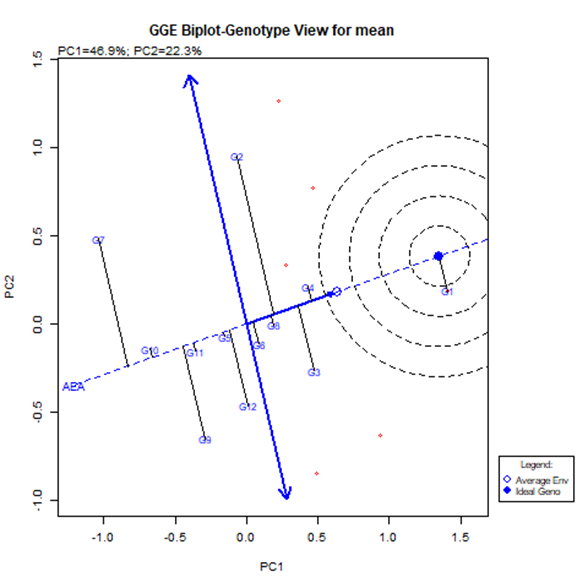การวิเคราะห์เสถียรภาพของอ้อยปลูกพันธุ์กำแพงแสน ชุดปี 2007 และ 2008 ด้วยวิธี GGE Biplot ในภาคตะวันออกเฉียงเหนือ| Stability Analysis in Plant Cane of Kamphaeng Saen Sugarcane Varieties Series 2007 and 2008 Using GGE Biplot Method in the Northeastern Region
Main Article Content
Abstract
Cane yield, sugar yield and CCS are the quantitative characters often vary across diverse environments due to significant genotype by environment interaction using GGE biplot. This study aimed to evaluate the stability and outstanding in plant cane of Kamphaeng Saen sugarcane varieties series 2007 and 2008 from 6 trials in sugarcane planting areas of the Northeastern region. Each trial was designed to use randomized complete block design with 3 replications being composed of 11 Kamphaeng Saen sugarcane varieties and Khon Kaen 3 as the checked variety. Considering the factors affecting the variation of the characters, it was found that cane yield had the high percentage sum square of 64.97 percent in the environment factor and had low percentage sum square of 6.63 percent in genetic factor. From the results of GGE biplot evaluation, it was found that the Kamphaeng Saen sugarcane varieties that had the outstanding and good stability was Kamphaeng Saen 07-6-2 in sugar yield and cane yield and Kamphaeng Saen 08-2-35 in CCS. Trials that had high potential in discriminating the outstanding of sugarcane verieties was Khon Buri in cane yield, Phimai in sugar yield and Don Tan in CCS. These trials could be used to represent locations for further studies.
บทคัดย่อ
ผลผลิตอ้อย ผลผลิตน้ำตาล และซีซีเอส เป็นลักษณะทางปริมาณที่มีการเปลี่ยนแปลงสูงเมื่อปลูก
ในสภาพแวดล้อมที่ต่างกัน เนื่องจากอิทธิพลของปฏิสัมพันธ์ระหว่างพันธุกรรมกับสภาพแวดล้อม สามารถวิเคราะห์เสถียรภาพและความดีเด่นของพันธุ์อ้อยในอ้อยปลูกโดยใช้วิธี GGE biplot การทดลองนี้จึงวิเคราะห์เสถียรภาพของอ้อยพันธุ์กำแพงแสน ชุดปี 2007 และ 2008 จากแปลงทดสอบ 6 แปลง ในพื้นที่ปลูกอ้อยของภาคตะวันออกเฉียงเหนือ แต่ละแปลงทดสอบ วางแผนการทดลองแบบบล็อกสมบูรณ์ จำนวน 3 ซ้ำ ประกอบด้วยอ้อยพันธุ์กำแพงแสน 11 พันธุ์ และพันธุ์ขอนแก่น 3 เป็นพันธุ์ตรวจสอบ จากการพิจารณาอิทธิพลของปัจจัยต่อความแปรปรวนของลักษณะ พบว่า%ความแปรปรวนจากสภาพแวดล้อมของผลผลิตอ้อยสูงถึง 64.97% ในขณะที่เปอร์เซ็นต์ความแปรปรวนจากพันธุกรรมมีค่าต่ำเพียง 6.63% จากผลการวิเคราะห์ GGE biplot พบว่า อ้อยพันธุ์กำแพงแสนที่มีศักยภาพและมีเสถียรภาพที่ดี คือ พันธุ์กำแพงแสน 07-6-2 ในผลผลิตน้ำตาลและผลผลิตอ้อย และพันธุ์กำแพงแสน 08-2-35 ในลักษณะซีซีเอส แปลงทดสอบที่มีศักยภาพในการแยกความแตกต่างของพันธุ์ได้ดีที่สุด ได้แก่ แปลงครบุรี ในลักษณะผลผลิตอ้อย แปลงพิมายในผลผลิตน้ำตาล และแปลงดอนตาลในลักษณะซีซีเอส แปลงทดสอบนี้สามารถใช้เป็นตัวแทนในการศึกษาครั้งต่อไปได้
Downloads
Article Details
References
ชูศักดิ์ จอมพุก. (2559). วิธีวิเคราะห์ทางพันธุศาสตร์ปริมาณในการปรับปรุงพันธุ์พืช. (น. 305-313). กรุงเทพฯ: นีโอดิจิตอล.
สำนักงานคณะกรรมการอ้อยและน้ำตาลทราย. (2562). รายงานพื้นที่การปลูกอ้อยปีการผลิต 2561/2562. สืบค้นจาก www.ocsb.go.th.
Akter, A., Hasan, M. J., Kulsum, U., Rahman, M. H., Khatun, M., & Islam, M. R. (2015). GGE biplot analysis for yield stability in multi-environment trials of promising hybrid rice (Oryza sativa L.). Bangladesh Rice Journal, 19(1), 1-8.
IRRI. (2014). Biometrics and breeding informatics. The Philippines, Laguna: International Rice Research Institute Los Baños
Jeberson, M. S., Kant, L., Kishore, N., Rana, V., Walia, D. P., & Singh, D. (2017). AMMI and GGE biplot analysis of yield stability and adaptability of elite genotypes of bread wheat (Triticum aestivum L.) for Northern Hill Zone of India. International Journal of Bio-resource and Stress Management, 8(5), 635-641.
Kadir, M., MUSA, Y., NUR, A., EFENDI, R., & SYAHRUDDIN, K. (2018). GGE-biplot analysis of yield stability in environment trial of tropical wheat (Triticum aestivum L.) genotype under dry season in Indonesia. Research on Crops, 19(4).
Krisnawati, A., & Adie, M. M. (2018). GGE biplot analysis of multi-environment yield trials in soybean promising lines. Ilmu Pertanian (Agricultural Science), 3(2), 72-81.
Laurie, S. M., & Booyse, M. (2015). Employing the GGE SREG model plus Elston index values for multiple trait selection in sweetpotato. Euphytica, 204(2), 433-442.
Luo, J., Pan, Y. B., Que, Y., Zhang, H., Grisham, M. P., & Xu, L. (2015). Biplot evaluation of test environments and identification of mega-environment for sugarcane cultivars in China. Scientific reports, 5(1), 1-11.
Mohammadi, R., Haghparast, R., Aghaee, M., Rostaee, M., & Pourdad, S. S. (2007). Biplot analysis of multi-environment trials for identification of winter wheat megaenvironments in Iran. World Journal of Agricultural Sciences, 3(4), 475-480.
Njei, A. M., Iwo, G. A., Ittah, M. A., Edet, O. E., & Emu, E. R. (2020). GGE biplot analysis of multi-location yield trial of ginger (Zingiber Officinale Rosc.) Genotypes in South-Eastern, Nigeria. Asian Journal of Agriculture and Rural Development, 10(1), 485-503.
Oliveira, T. R. A. D., Carvalho, H. W. L. D., Oliveira, G. H. F., Costa, E. F. N., Gravina, G. D. A., Santos, R. D. D., & Carvalho, J. L. S. D. (2019). Hybrid maize selection through GGE biplot analysis. Bragantia, 78, 166-174.
Pagi, N., Prajapati, N., Pachchigar, K., Dharajiya, D., Solanki, S. D., Soni, N., & Patel, P. (2017). GGE biplot analysis for yield performance of grain amaranth genotypes across different environments in western India. J Exp Biol Agric Sci, 5(3), 368-376.
Ramburan, S., & Zhou, M. (2011, August). Investigating sugarcane genotype x environment interactions under rainfed conditions in South Africa using variance components and biplot analysis. In Proceedings of the South African Sugar Technologists’ Association (Vol. 84, pp. 345-358).
Sabaghnia, N., Dehghani, H., & Sabaghpour, S. H. (2006). Nonparametric methods for interpreting genotype× environment interaction of lentil genotypes. Crop science, 46(3), 1100-1106.
Sharma, S. P., Leskovar, D. I., Crosby, K. M., & Ibrahim, A. M. H. (2020). GGE biplot analysis of genotype-by-environment interactions for melon fruit yield and quality traits. HortScience, 55(4), 533-542.
Singh, C., Gupta, A., Gupta, V., Kumar, P., Sendhil, R., Tyagi, B. S., ... & Singh, G. P. (2019). Genotype x environment interaction analysis of multi-environment wheat trials in India using AMMI and GGE biplot models. Crop Breeding and Applied Biotechnology, 19, 309-318.
Susanto, U., Rohaeni, W. R., Johnson, S. B., & Jamil, A. (2015). GGE biplot analysis for genotype x environment interaction on yield trait of high Fe content rice genotypes in Indonesian irrigated environments. AGRIVITA, Journal of Agricultural Science, 37(3), 265-275.
Ukalski, K., & Klisz, M. (2016). Application of GGE biplot graphs in multi-environment trials on selection of forest trees. Folia Forestalia Polonica, 58(4), 228-239.
Venables,W.N., Smith, D.M.,& the R Development Core Team. (2009). An Introduction to R. Available Retrieved January 24, 2020, from www.R-project.org.
XU, N. Y., Fok, M., Zhang, G. W., Jian, L. I., & ZHOU, Z. G. (2014). The application of GGE biplot analysis for evaluat ng test locations and mega-environment investigation of cotton regional trials. Journal of Integrative Agriculture, 13(9), 1921-1933.
Yan, W., & Tinker, N. A. (2006). Biplot analysis of multi-environment trial data: Principles and applications. Canadian journal of plant science, 86(3), 623-645.
Yan, W., Hunt, L. A., Sheng, Q., & Szlavnics, Z. (2000). Cultivar evaluation and mega‐environment investigation based on the GGE biplot. Crop science, 40(3), 597-605.

